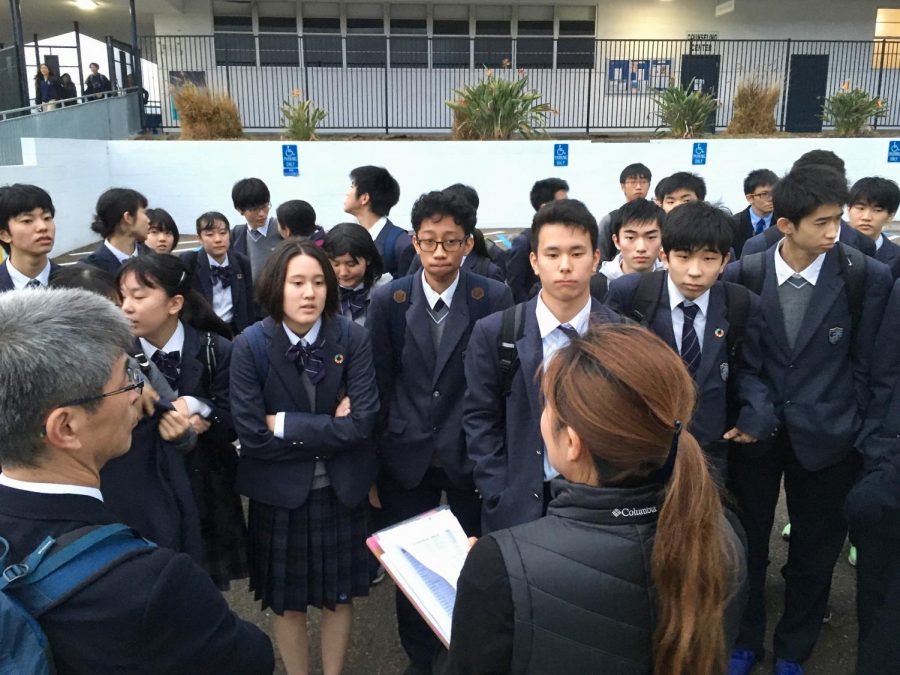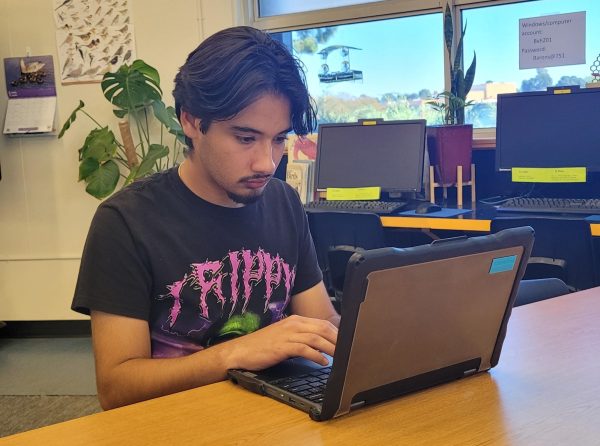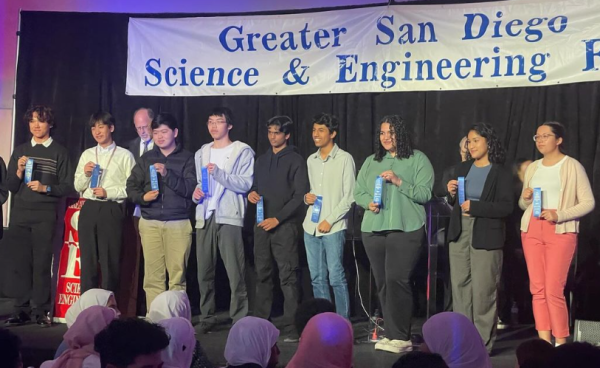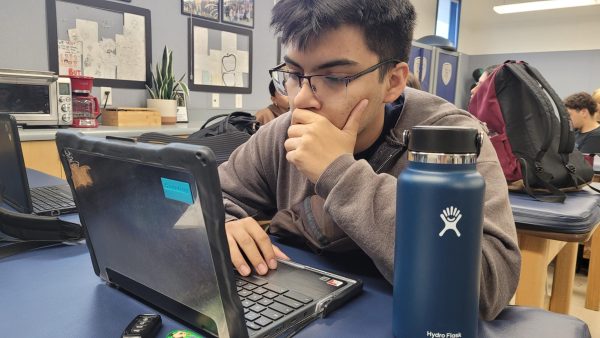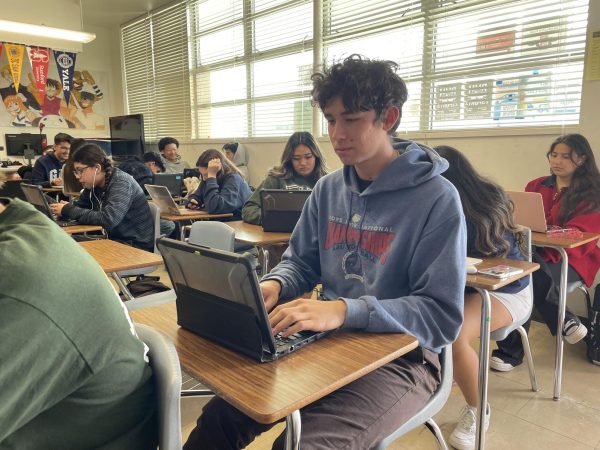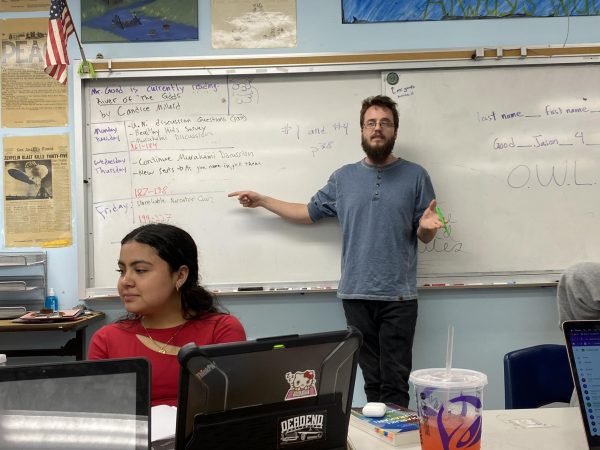All the way from Japan
BVH hosts Japanese Delegates with help from EduAbroad
On Wednesday, Nov. 20th, 2019, International Japanese delegates wait for their assigned guides to arrive. The delegates were taken to the cafeteria before following their guides around the school and to their classes.
On Wednesday, Nov. 20, 2019, Japanese students arrived on Bonita Vista High’s (BVH) campus, awaiting their assigned hosts and guides. For his first time ever, 9th grade Geography teacher and 10th grade World History teacher, Timothy Woolston, worked closely with EduAbroad in order to give the Japanese students the experience of American school-life and culture. While offering a new experience to these international students, BVH students also learned more about Japan and the difference in life is compared to America.
“[Showing students around is] fun [and] I’m sad they’re only here for a little bit of time. Since they’re here, they get to come around to my classes, and it’s cool to let them experience this kind of school style, because it’s really different than how it is in Japan,” sophomore and host Sydney Wunderly said.
Like a few other chosen students, Wunderly was selected to guide Japanese student, Kota Takahashi, whose American name is “Jessie,” around the BVH campus and to her classrooms. In previous years, Assistant Principal of Student Activities, Christopher Alvarez, would organize hosting for international students, but as of 2019, Woolston took on the responsibility to organize the event.
“The principal, [Roman Del Rosario, Ed.D.], and [Alvarez] asked me to pick eight kids from each class to host. They wanted sophomores and freshmen, so that’s why they came to me because I teach sophomores and freshmen,” Woolston said.
EduAbroad is an education consulting firm that delivers educational services to students from around the world who choose to study abroad in order to make opportunities like international student exchange possible.
As a part of the arrival of the Japanese students, BVH and Japanese students learned about the cultural and social aspects of Japan by conversing with one another. Some of the social differences that were mentioned by Wunderly were the gestures, like bowing, and polite inclinations.
“I learned about [the] differences in life and culture from Japan. Everything you see here is new and innovative for you,” Takahashi said.
Woolston organized his students into groups with a Japanese student in order for BVH students to ask questions. According to Woolston, there were obstacles such as language barriers, which resulted in BVH students having to simplify their language in order to achieve communication with Japanese students.
“A funny thing I had them try [was] teach a slang word to the Japanese students. They would tell the Japanese kids how to say ‘bet’ but they couldn’t [because] they have no explanation for it. Or ‘vibes,’ or ‘vibing.’ They had no idea [how to explain these words], so having them even think about the words that they use on a regular basis was an interesting exchange,” Woolston said.
Wunderly took Takahashi to each of her classrooms, where he was able to learn more about American school life and the students. Often times, Wunderly would pull out her phone and open Translate Now, a translating app in order to communicate with Takahashi. By doing so, she gained better communication with Takahashi, which helped them discuss the differences between the American and Japanese cultures.
“I’ve learned that everyone knows a lot about America, but America doesn’t really know about the rest of the world. We’re kind of closed off. We just think about American politics and all that stuff,” Wunderly said. “We’re all about being American, which they don’t do in Japan, so it’s cool.”
Hosting students was also an option for teachers, as well. What started off as a staff meeting about hosting Japanese students, ended with AP Photography, Photography, Computer Art and Filipino teacher Edwin Lim volunteering to host Momo Uemura. Lim has hosted International students in the past, so offering Uemura his home was not something new.
“It’s a lot of fun. Most of the time, these are good, kind, wonderful students and Momo is one of them. She’s 15 and she has just integrated herself into the family: kind, sweet, empathetic human being,” Lim said.
Part of hosting Uemura meant that connections with other cultures would influence Lim’s family. Lim has hosted Japanese, Brazilian and Belgian students, which gave his kids experience with meeting people from different countries.
“I’m an immigrant myself. I came to the U.S. when I was 15. So, I have to see myself in the students. It’s scary; you leave everything [and] come to a new country. Thank God [Uemura’s] already kind. She was in Ireland last year, so she has this real-life experience, and she’s able to share [those experiences] with my kids,” Lim said.
Because Uemura left on Thursday, Nov. 28, 2019, Lim had made plans to host another student from Brazil. In total, Lim claims to have hosted 20 to 30 International students throughout his life.
“It’s just a wonderful life experience for me and the kids. I learned a lot more about Japan that I wouldn’t have learned about otherwise. It’s a risk, but I think it’s [also] a big reward to share your home with another kind, young person,” Lim said.
Like Uemura, the Japanese students were scheduled to leave on Thursday, Nov. 28, 2019, leaving the students a week to experience San Diego. As a host, Lim had made plans to show Uemura around San Diego, but what he mostly prioritized was taking Uemura to the circus his kids were a part of.
“All of my students are upset that the [Japanese] kids are leaving. They made friends with them on that first day, which was important to me that they established that early,” Woolston said. “They exchanged Instagrams and gamer tags to play video games on and downloaded some of the apps that are popular with the Japanese kids.”
With the introduction of the Japanese students came moments that helped bring a new perspective and experience to the BVH campus, and according to Woolston, helped teach students sympathy for people learning a second language. As a result of this event, students and teachers alike understand the disparate in American culture compared to other cultures.
“Anytime you have people from other cultures meeting each other, stereotypes are going to be broken and relationships are going to be built. That was important to me because a lot of our kids can have very simplistic stereotypes about other people, and that’s because they’re not exposed to those people,” Woolston said. “I think that for the Japanese students on the other side, they had stereotypes about Americans, and were pleasantly surprised at how hospitable our kids were.”
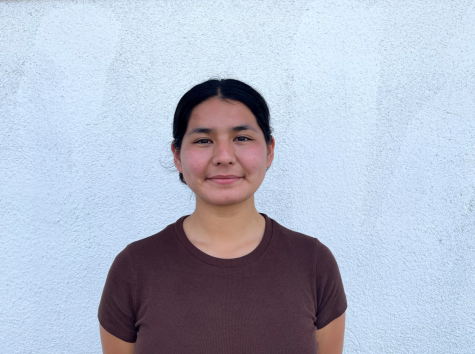
Howdy! Currently, I am a senior at Bonita Vista High and finishing my fourth year on the Crusader staff. Now, I am co-Editor in Chief of the Crusader,...

